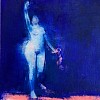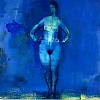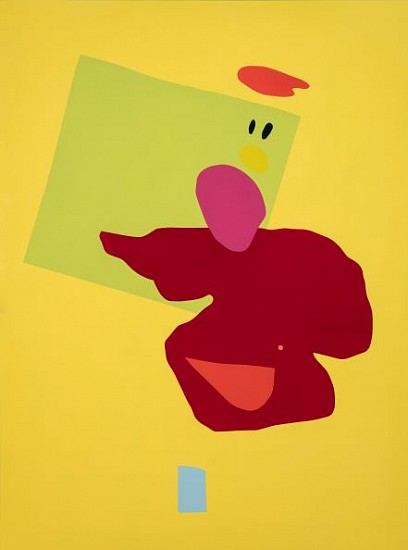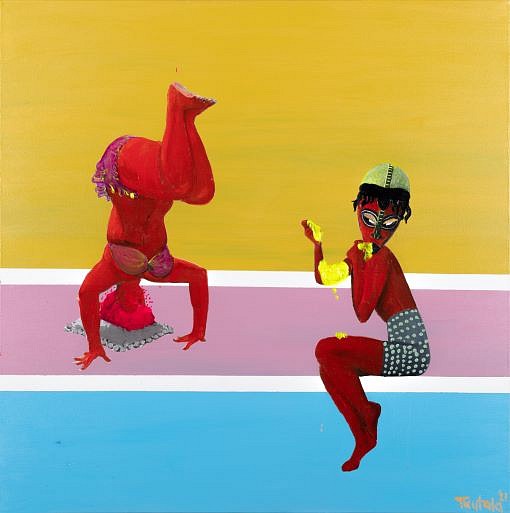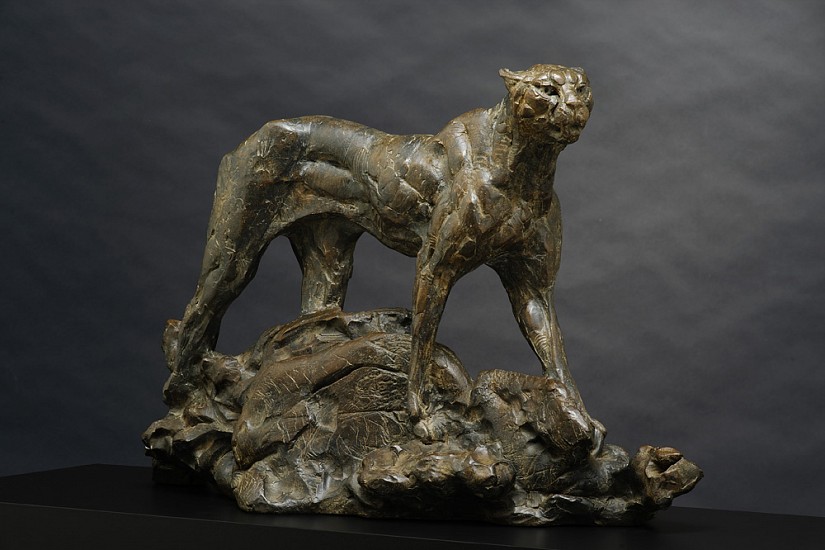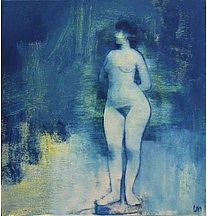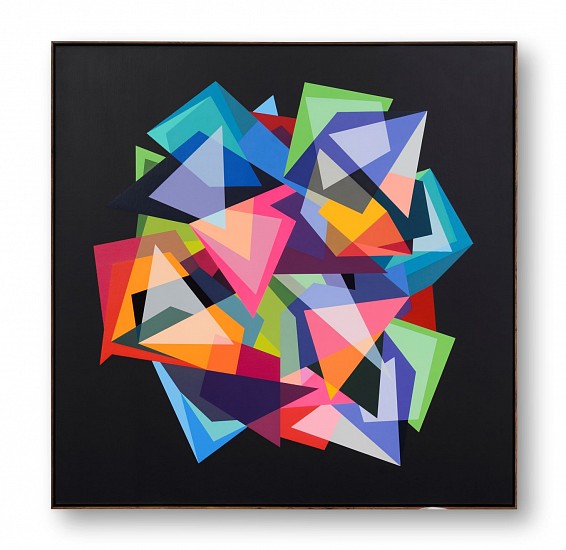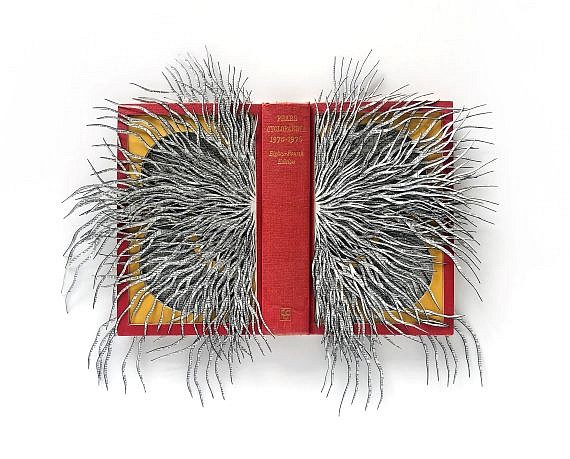SUMMER EXHIBITION 2022
Liberty Battson is inspired by Modernism, more specifically the Modernist theories around abstraction and the pursuit for ‘truth’ and ‘true art’. More recently, Battson has used Dadaism as her source of inspiration, using unconventional ways of transferring paint to canvas. She focuses on the aesthetic of abstraction to conceptually address bigger issues and encourages the audience to decode the artwork through the playful engagement.
Liberty Battson is inspired by Modernism, more specifically the Modernist theories around abstraction and the pursuit for ‘truth’ and ‘true art’. More recently, Battson has used Dadaism as her source of inspiration, using unconventional ways of transferring paint to canvas. She focuses on the aesthetic of abstraction to conceptually address bigger issues and encourages the audience to decode the artwork through the playful engagement.
Liberty Battson is inspired by Modernism, more specifically the Modernist theories around abstraction and the pursuit for ‘truth’ and ‘true art’. More recently, Battson has used Dadaism as her source of inspiration, using unconventional ways of transferring paint to canvas. She focuses on the aesthetic of abstraction to conceptually address bigger issues and encourages the audience to decode the artwork through the playful engagement.
Deborah Bell is one of South Africa’s most celebrated contemporary artists. She works in a range of media on canvas and paper, produces dry point etchings and large-scale bronzes. She has developed an immediately recognisable visual language, her images simple, stark, symbolic – grounded, silent, still, poised. In her iconography she draws from a range of cultures, philosophies and psychologies, with her work arriving out of an internal and personal place that Bell occupies in the world as an artist, a woman and an explorer.
Deborah Bell is one of South Africa’s most celebrated contemporary artists. She works in a range of media on canvas and paper, produces dry point etchings and large-scale bronzes. She has developed an immediately recognisable visual language, her images simple, stark, symbolic – grounded, silent, still, poised. In her iconography she draws from a range of cultures, philosophies and psychologies, with her work arriving out of an internal and personal place that Bell occupies in the world as an artist, a woman and an explorer.
Emalie Bingham uses pattern-making and surface design as a medium through which she interrogates societal patterns and conventions. For Bingham, drawing provides both refuge and stimulation, detachment from and an intense connection to the world around and within her. She describes it as the ultimate meditation, enabling her to both accept her limitations and use her practice to transcend them. Her paintings are striking compositions created from her hand-drawn designs which are often edgy, satirical, humorous and self-reflexive.
Emalie Bingham uses pattern-making and surface design as a medium through which she interrogates societal patterns and conventions. For Bingham, drawing provides both refuge and stimulation, detachment from and an intense connection to the world around and within her. She describes it as the ultimate meditation, enabling her to both accept her limitations and use her practice to transcend them. Her paintings are striking compositions created from her hand-drawn designs which are often edgy, satirical, humorous and self-reflexive.
Emalie Bingham uses pattern-making and surface design as a medium through which she interrogates societal patterns and conventions. For Bingham, drawing provides both refuge and stimulation, detachment from and an intense connection to the world around and within her. She describes it as the ultimate meditation, enabling her to both accept her limitations and use her practice to transcend them. Her paintings are striking compositions created from her hand-drawn designs which are often edgy, satirical, humorous and self-reflexive.
One of South Africa’s most accomplished sculptors, du Toit describes being liberated by the advent of democracy in South Africa from having to concern himself and his art with the notions of identity, and he has happily turned his attention to pursuits such as reveling in form, concept and medium for their own sakes.
Du Toit’s hares have a lightness of being – they dance, they fly, they sit pondering their thoughts. They are like quick sketches in the landscape, something glimpsed out the corner of the eye, like a flash of truth.
One of South Africa’s most accomplished sculptors, du Toit describes being liberated by the advent of democracy in South Africa from having to concern himself and his art with the notions of identity, and he has happily turned his attention to pursuits such as reveling in form, concept and medium for their own sakes.
Du Toit’s hares have a lightness of being – they dance, they fly, they sit pondering their thoughts. They are like quick sketches in the landscape, something glimpsed out the corner of the eye, like a flash of truth
Born in Algeria, Guy Ferrer is a French artist of Catalan and Italian descent. He is an artist who helps us hold onto poetry and defies the trend towards abandoning wondering. In a career spanning some 35 years, Ferrer continues to express wonder and mystery, lyricism and faith in the works that emerge from his studio in Perpignan, France.
Ferrer’s work is fundamentally concerned with the mystery and beauty of life, with what’s beyond and unknowable. His driving energy, it seems, comes from a spiritual necessity to make art as part on an ongoing search for solace and meaning. His paintings, drawings and sculpture seem to vibrate with an ethereal energy, and they connect at the deepest level with audiences across countries and cultures.
‘We heal by retelling our stories.’
Teresa Kutala Firmino’s work negotiates trauma, both personal and collective, in everyday life. Her paintings are constructed scenes of the past and present, which are sometimes intertwined. Firmino carefully collects images from magazines, newspapers, historical documents and social media, and places them in colourful, box-like stages. This creates surreally baroque scenes which take place in tightly confined interiors, where the characters have the opportunity to re-enact their stories or construct new ones. This process allows Firmino to create alternative past, present and future narratives of Africa, thus rebuilding her own archive of African history.
‘We heal by retelling our stories.’
Teresa Kutala Firmino’s work negotiates trauma, both personal and collective, in everyday life. Her paintings are constructed scenes of the past and present, which are sometimes intertwined. Firmino carefully collects images from magazines, newspapers, historical documents and social media, and places them in colourful, box-like stages. This creates surreally baroque scenes which take place in tightly confined interiors, where the characters have the opportunity to re-enact their stories or construct new ones. This process allows Firmino to create alternative past, present and future narratives of Africa, thus rebuilding her own archive of African history.
Chonat Getz works mainly in the media of printmaking and sculpture. Formerly a Mathematics lecturer at the University of the Witwatersrand for thirty years, she draws on her expertise in mathematics, elucidating the nexus between mathematics and traditional African craft objects.
Chonat Getz works mainly in the media of printmaking and sculpture. Formerly a Mathematics lecturer at the University of the Witwatersrand for thirty years, she draws on her expertise in mathematics, elucidating the nexus between mathematics and traditional African craft objects.
Chonat Getz works mainly in the media of printmaking and sculpture. Formerly a Mathematics lecturer at the University of the Witwatersrand for thirty years, she draws on her expertise in mathematics, elucidating the nexus between mathematics and traditional African craft objects.
Chonat Getz works mainly in the media of printmaking and sculpture. Formerly a Mathematics lecturer at the University of the Witwatersrand for thirty years, she draws on her expertise in mathematics, elucidating the nexus between mathematics and traditional African craft objects.
Dylan Lewis is Africa’s most internationally renowned living figurative sculptor. Collectively Lewis’ bronzes of felines form perhaps the most powerful commentary on nature and wilderness that has been made by any artist of this era. Whilst his cat sculptures have attracted collectors’ attention, Lewis has gradually shifted vision and focus onto the human figure. Elements of humanity began to be hinted at in some early sculptures in the artists development. A growing body of recent work featuring highly charged emotional and erotic human forms now dominate much of this fascinating sculptor’s work.
Dylan Lewis is Africa’s most internationally renowned living figurative sculptor. Collectively Lewis’ bronzes of felines form perhaps the most powerful commentary on nature and wilderness that has been made by any artist of this era. Whilst his cat sculptures have attracted collectors’ attention, Lewis has gradually shifted vision and focus onto the human figure. Elements of humanity began to be hinted at in some early sculptures in the artists development. A growing body of recent work featuring highly charged emotional and erotic human forms now dominate much of this fascinating sculptor’s work.
Dylan Lewis is Africa’s most internationally renowned living figurative sculptor. Collectively Lewis’ bronzes of felines form perhaps the most powerful commentary on nature and wilderness that has been made by any artist of this era. Whilst his cat sculptures have attracted collectors’ attention, Lewis has gradually shifted vision and focus onto the human figure. Elements of humanity began to be hinted at in some early sculptures in the artists development. A growing body of recent work featuring highly charged emotional and erotic human forms now dominate much of this fascinating sculptor’s work.
Dylan Lewis is Africa’s most internationally renowned living figurative sculptor. Collectively Lewis’ bronzes of felines form perhaps the most powerful commentary on nature and wilderness that has been made by any artist of this era. Whilst his cat sculptures have attracted collectors’ attention, Lewis has gradually shifted vision and focus onto the human figure. Elements of humanity began to be hinted at in some early sculptures in the artists development. A growing body of recent work featuring highly charged emotional and erotic human forms now dominate much of this fascinating sculptor’s work.
Dylan Lewis is Africa’s most internationally renowned living figurative sculptor. Collectively Lewis’ bronzes of felines form perhaps the most powerful commentary on nature and wilderness that has been made by any artist of this era. Whilst his cat sculptures have attracted collectors’ attention, Lewis has gradually shifted vision and focus onto the human figure. Elements of humanity began to be hinted at in some early sculptures in the artists development. A growing body of recent work featuring highly charged emotional and erotic human forms now dominate much of this fascinating sculptor’s work.
Kilmany-Jo Liversage creates works that intentionally blur the boundary between fine art and street art. Her subjects are inspired by Renaissance era portraiture and still life compositions, all captured with the language of graffiti or urban art. She updates, renews, and challenges the conventions of painting.
Kilmany-Jo Liversage creates works that intentionally blur the boundary between fine art and street art. Her subjects are inspired by Renaissance era portraiture and still life compositions, all captured with the language of graffiti or urban art. She updates, renews, and challenges the conventions of painting.
Kilmany-Jo Liversage creates works that intentionally blur the boundary between fine art and street art. Her subjects are inspired by Renaissance era portraiture and still life compositions, all captured with the language of graffiti or urban art. She updates, renews, and challenges the conventions of painting.
Kilmany-Jo Liversage creates works that intentionally blur the boundary between fine art and street art. Her subjects are inspired by Renaissance era portraiture and still life compositions, all captured with the language of graffiti or urban art. She updates, renews, and challenges the conventions of painting.
‘I attempt to re-connect with the deeply embedded narratives which underpin the dichotomies of the contemporary human experience at both a microcosmic and macrocosmic level thus revealing the paradoxes, irony, contrasts, and counter-points that are in constant friction to one another, and yet are always interdependent. It is from this that disparate images arise in which the fragility and instability of our seemingly certain reality is questioned and where the results are deconstructed in an attempt to subvert meaning so as to enable a multifaceted interpretation.’
– Lorienne Lotz
‘I attempt to re-connect with the deeply embedded narratives which underpin the dichotomies of the contemporary human experience at both a microcosmic and macrocosmic level thus revealing the paradoxes, irony, contrasts, and counter-points that are in constant friction to one another, and yet are always interdependent. It is from this that disparate images arise in which the fragility and instability of our seemingly certain reality is questioned and where the results are deconstructed in an attempt to subvert meaning so as to enable a multifaceted interpretation.’
– Lorienne Lotz
The subject matter of Mason’s work, although wide and varied, is typically centred around the aesthetic use of colour, form and texture. This collection of diminutive nudes are rendered in a dreamy midnight blues pay homage to the sinuous nature of the female form. ‘I seem to paint smaller works when I am surrounded by uncertainty. Both in the world and also my creative journey. I have really enjoyed painting these smaller female figures, I like the energy I can capture by working the whole surface of the painting at the same time. I suppose they represent the elusive muse. An artist’s inspiration. That feeling that exists just out of reach. Sometimes only when we are dreaming.’
– Louise Mason
The subject matter of Mason’s work, although wide and varied, is typically centred around the aesthetic use of colour, form and texture. This collection of diminutive nudes are rendered in a dreamy midnight blues pay homage to the sinuous nature of the female form. ‘I seem to paint smaller works when I am surrounded by uncertainty. Both in the world and also my creative journey. I have really enjoyed painting these smaller female figures, I like the energy I can capture by working the whole surface of the painting at the same time. I suppose they represent the elusive muse. An artist’s inspiration. That feeling that exists just out of reach. Sometimes only when we are dreaming.’
– Louise Mason
The subject matter of Mason’s work, although wide and varied, is typically centred around the aesthetic use of colour, form and texture. This collection of diminutive nudes are rendered in a dreamy midnight blues pay homage to the sinuous nature of the female form. ‘I seem to paint smaller works when I am surrounded by uncertainty. Both in the world and also my creative journey. I have really enjoyed painting these smaller female figures, I like the energy I can capture by working the whole surface of the painting at the same time. I suppose they represent the elusive muse. An artist’s inspiration. That feeling that exists just out of reach. Sometimes only when we are dreaming.’
– Louise Mason
The subject matter of Mason’s work, although wide and varied, is typically centred around the aesthetic use of colour, form and texture. This collection of diminutive nudes are rendered in a dreamy midnight blues pay homage to the sinuous nature of the female form. ‘I seem to paint smaller works when I am surrounded by uncertainty. Both in the world and also my creative journey. I have really enjoyed painting these smaller female figures, I like the energy I can capture by working the whole surface of the painting at the same time. I suppose they represent the elusive muse. An artist’s inspiration. That feeling that exists just out of reach. Sometimes only when we are dreaming.’
– Louise Mason
The subject matter of Mason’s work, although wide and varied, is typically centred around the aesthetic use of colour, form and texture. This collection of diminutive nudes are rendered in a dreamy midnight blues pay homage to the sinuous nature of the female form. ‘I seem to paint smaller works when I am surrounded by uncertainty. Both in the world and also my creative journey. I have really enjoyed painting these smaller female figures, I like the energy I can capture by working the whole surface of the painting at the same time. I suppose they represent the elusive muse. An artist’s inspiration. That feeling that exists just out of reach. Sometimes only when we are dreaming.’
– Louise Mason
The subject matter of Mason’s work, although wide and varied, is typically centred around the aesthetic use of colour, form and texture. This collection of diminutive nudes are rendered in a dreamy midnight blues pay homage to the sinuous nature of the female form. ‘I seem to paint smaller works when I am surrounded by uncertainty. Both in the world and also my creative journey. I have really enjoyed painting these smaller female figures, I like the energy I can capture by working the whole surface of the painting at the same time. I suppose they represent the elusive muse. An artist’s inspiration. That feeling that exists just out of reach. Sometimes only when we are dreaming.’
– Louise Mason
The subject matter of Mason’s work, although wide and varied, is typically centred around the aesthetic use of colour, form and texture. This collection of diminutive nudes are rendered in a dreamy midnight blues pay homage to the sinuous nature of the female form. ‘I seem to paint smaller works when I am surrounded by uncertainty. Both in the world and also my creative journey. I have really enjoyed painting these smaller female figures, I like the energy I can capture by working the whole surface of the painting at the same time. I suppose they represent the elusive muse. An artist’s inspiration. That feeling that exists just out of reach. Sometimes only when we are dreaming.’
– Louise Mason
The subject matter of Mason’s work, although wide and varied, is typically centred around the aesthetic use of colour, form and texture. This collection of diminutive nudes are rendered in a dreamy midnight blues pay homage to the sinuous nature of the female form. ‘I seem to paint smaller works when I am surrounded by uncertainty. Both in the world and also my creative journey. I have really enjoyed painting these smaller female figures, I like the energy I can capture by working the whole surface of the painting at the same time. I suppose they represent the elusive muse. An artist’s inspiration. That feeling that exists just out of reach. Sometimes only when we are dreaming.’
– Louise Mason
The subject matter of Mason’s work, although wide and varied, is typically centred around the aesthetic use of colour, form and texture. This collection of diminutive nudes are rendered in a dreamy midnight blues pay homage to the sinuous nature of the female form. ‘I seem to paint smaller works when I am surrounded by uncertainty. Both in the world and also my creative journey. I have really enjoyed painting these smaller female figures, I like the energy I can capture by working the whole surface of the painting at the same time. I suppose they represent the elusive muse. An artist’s inspiration. That feeling that exists just out of reach. Sometimes only when we are dreaming.’
– Louise Mason
Nigel Mullins’ painterly exploration makes use of sumptuous impasto, veering between figuration and abstraction without restraint. The artist applies his material as libations covering a sacred artefact or an amulet: fetishistically. The paint, dense in meaning and referential value, thickly covers the support as it alters and constructs. This explicitly references the painting as a thing; a support to which meaning (as material) is applied often in layers and over an expanse of time.
Nigel Mullins’ painterly exploration makes use of sumptuous impasto, veering between figuration and abstraction without restraint. The artist applies his material as libations covering a sacred artefact or an amulet: fetishistically. The paint, dense in meaning and referential value, thickly covers the support as it alters and constructs. This explicitly references the painting as a thing; a support to which meaning (as material) is applied often in layers and over an expanse of time.
‘Whereas before, my animal sculptures might symbolically mock predators, policemen, politicians, oligarchs, sycophants, the corrupted and the like, during lockdown I felt impelled to look closer to home for my subject matter. My interests had been shifting from perpetrators to people and I have been wanting to transition from an accusatory position to one that is more compassionate and empathetic.
– Brett Murray
Brett Murray’s recent sculptures have a shared sense of vulnerability and fragility about them, not unlike the Japanese netsuke that inspired them. His symbolic portraits represent all of us, looking skywards for answers and certainty.
Gary Stephens’ portraits pay homage to the African traditions of hair-braiding, hats, headscarves and contemporary urban style. Many of his drawings focus on the iconic power of a subject’s hair or headdress rather than their specific facial features. Stephens portrays women in head scarves or men in hats to focus attention on the power of these everyday symbols of African life and to capture a sense of contemporary African style and flair for fashion. Stephens is drawn to patterns and visual rhythms, such as geometric repetitions, textile patterns, or botanical shapes. He is attracted to non-verbal, hypnotic visual experiences and often creates layers of patterns that offset and energize the image in the foreground.
Gary Stephens’ portraits pay homage to the African traditions of hair-braiding, hats, headscarves and contemporary urban style. Many of his drawings focus on the iconic power of a subject’s hair or headdress rather than their specific facial features. Stephens portrays women in head scarves or men in hats to focus attention on the power of these everyday symbols of African life and to capture a sense of contemporary African style and flair for fashion. Stephens is drawn to patterns and visual rhythms, such as geometric repetitions, textile patterns, or botanical shapes. He is attracted to non-verbal, hypnotic visual experiences and often creates layers of patterns that offset and energize the image in the foreground.
Gary Stephens’ portraits pay homage to the African traditions of hair-braiding, hats, headscarves and contemporary urban style. Many of his drawings focus on the iconic power of a subject’s hair or headdress rather than their specific facial features. Stephens portrays women in head scarves or men in hats to focus attention on the power of these everyday symbols of African life and to capture a sense of contemporary African style and flair for fashion. Stephens is drawn to patterns and visual rhythms, such as geometric repetitions, textile patterns, or botanical shapes. He is attracted to non-verbal, hypnotic visual experiences and often creates layers of patterns that offset and energize the image in the foreground.
Depicting inner landscapes has long been South African artist, Penelope Stutterheime’s preoccupation. Drawing inspiration from dreams and the unconscious, her layered and textured oil paintings use impasto and intensely vibrant colour to create mesmerising abstract works
‘I believe I can be better than the machine.’ The street runs deeply in his Andrzej Urbanski blood. The artist left his days of full-time train ‘bombing’ back in Berlin where he started writing in his teens and now creates large, shimmering, optically bending artworks composed from the architectural squares, triangles and hexagons of today’s contemporary built environment.
‘I believe I can be better than the machine.’ The street runs deeply in his Andrzej Urbanski blood. The artist left his days of full-time train ‘bombing’ back in Berlin where he started writing in his teens and now creates large, shimmering, optically bending artworks composed from the architectural squares, triangles and hexagons of today’s contemporary built environment.
‘I believe I can be better than the machine.’ The street runs deeply in his Andrzej Urbanski blood. The artist left his days of full-time train ‘bombing’ back in Berlin where he started writing in his teens and now creates large, shimmering, optically bending artworks composed from the architectural squares, triangles and hexagons of today’s contemporary built environment.
‘Texture and patina are important elements in my work. But more essentially the laying bare of the past – looking for something like an unreachable truth – uncovering hidden layers of paint, is what drives me as an artist.
I reproduce the effects of time using all sort of tools such as knives and spatulas, but also chemicals and waxes, sandpaper and glue. It is a gruelling and a very physical exercise, constantly scratching, rubbing and sanding off layers of paint – each layer needing to dry and be “worked out” before the next one can be applied.
My work is abstract in essence, each piece being an object in itself. I work under the urge of bringing together interacting elements – a kind of vital incubation – producing eventually an epiphany of forms, textures and colours.’
– Philippe Uzac
Shany van den Berg’s practice centres on contemporary portraiture and figurative work, with an underlying theme of womanhood. Her ethereal oil paintings evoke the mood and texture of Old Master paintings, conveying complex emotions and ideas through meticulous attention to detail, an extraordinary facility with paint and subtle symbolism. Van den Berg’s portraiture is most often of women, whose features morph into a composite of the artist and her loved ones, serving as portals to narratives of sacrifice, struggle and ultimately transcendence.
Shany van den Berg’s practice centres on contemporary portraiture and figurative work, with an underlying theme of womanhood. Her ethereal oil paintings evoke the mood and texture of Old Master paintings, conveying complex emotions and ideas through meticulous attention to detail, an extraordinary facility with paint and subtle symbolism. Van den Berg’s portraiture is most often of women, whose features morph into a composite of the artist and her loved ones, serving as portals to narratives of sacrifice, struggle and ultimately transcendence.
Barbara Wildenboer uses a combination of analogue and digital processes to create sculptural artworks that consist of collage, photo and paper-construction as well as digitally animated photographic sculpture. Wildenboer also creates delicately-cut altered books which often contain maps, atlases and scientific subject matter, sometimes using images from the book as central elements to her pieces. Imagery and words become components of the larger designs, as she crafts new visual narratives from the raw material.
Barbara Wildenboer uses a combination of analogue and digital processes to create sculptural artworks that consist of collage, photo and paper-construction as well as digitally animated photographic sculpture. Wildenboer also creates delicately-cut altered books which often contain maps, atlases and scientific subject matter, sometimes using images from the book as central elements to her pieces. Imagery and words become components of the larger designs, as she crafts new visual narratives from the raw material.
Barbara Wildenboer uses a combination of analogue and digital processes to create sculptural artworks that consist of collage, photo and paper-construction as well as digitally animated photographic sculpture. Wildenboer also creates delicately-cut altered books which often contain maps, atlases and scientific subject matter, sometimes using images from the book as central elements to her pieces. Imagery and words become components of the larger designs, as she crafts new visual narratives from the raw material.
For almost three decades Florian Wozniak has worked independently as a contemporary artist in South Africa. Working primarily in bronze, the artist’s smooth, figurative forms feel rooted to the earth and convey a powerful serenity. His sculptures are by turns tender and endearing, playful and witty; his characters often evoking pathos or humour.
For almost three decades Florian Wozniak has worked independently as a contemporary artist in South Africa. Working primarily in bronze, the artist’s smooth, figurative forms feel rooted to the earth and convey a powerful serenity. His sculptures are by turns tender and endearing, playful and witty; his characters often evoking pathos or humour.




































